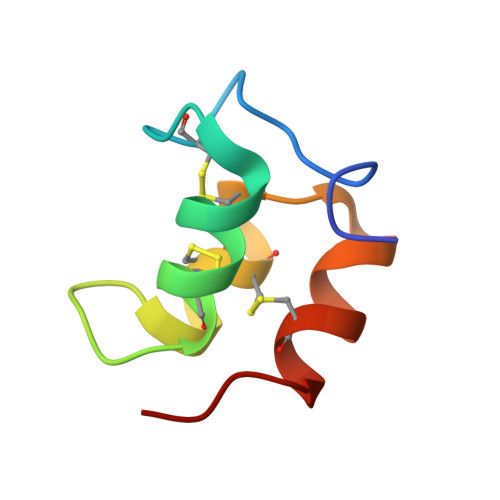Molecular cold-adaptation: Comparative analysis of two homologous families of psychrophilic and mesophilic signal proteins of the protozoan ciliate, Euplotes.
Alimenti, C., Vallesi, A., Pedrini, B., Wuthrich, K., Luporini, P.(2009) IUBMB Life 61: 838-845
- PubMed: 19621350
- DOI: https://doi.org/10.1002/iub.228
- Primary Citation of Related Structures:
2KC6 - PubMed Abstract:
Unique opportunities are provided by phylogenetically closely related organisms thriving in stably cold, or temperate milieus to study adaptive modifications of structurally homologous molecules. These modifications are of keen interest in basic science as well as in biotechnology. This review highlights structural and functional specificities that differentiate two homologous families of psychrophilic and mesophilic water-borne proteins (designated as pheromones) that signal mitotic growth and sexual mating in two marine species of the protozoan ciliate Euplotes, i.e., E. nobilii, which is distributed in Antarctic and Arctic waters, and E. raikovi, which inhabits temperate waters. The two protein families show strict conservation of a common three-helix bundle in a compact core of the molecular structure, which provides long-lasting integrity and biological activity to these molecules in their natural environment. In the psychrophilic pheromone family, cold-adaptation appears to have been achieved by superimposing an integrated complex of structural modifications on this conserved scaffold. Functionally most relevant appear to be extensions of polypeptide segments devoid of regular secondary structures, a specific distribution of polar and hydrophobic amino acids, the presence of solvent-exposed clusters of negatively charged amino acid side chains, and a unique role of aromatic residues in anchoring the molecular architecture. Due to these modifications, the psychrophilic pheromones are an example of an elegant combination of high stability of the three-dimensional structures with sufficient structural plasticity for efficient functioning at their physiologically low temperatures.
- Dipartimento di Biologia Molecolare Cellulare e Animale, University of Camerino, Camerino (MC), Italy.
Organizational Affiliation:
















